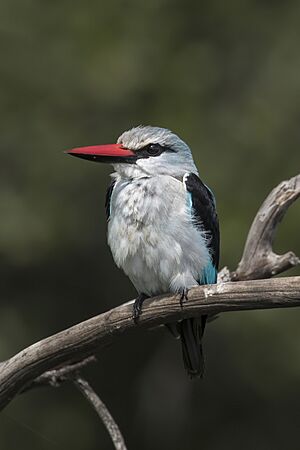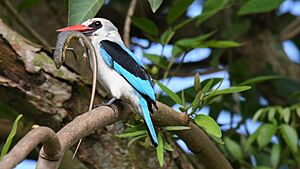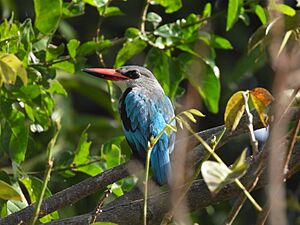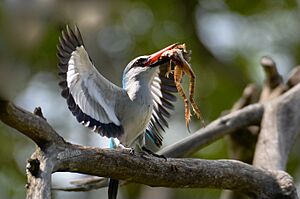Woodland kingfisher facts for kids
Quick facts for kids Woodland kingfisher |
|
|---|---|
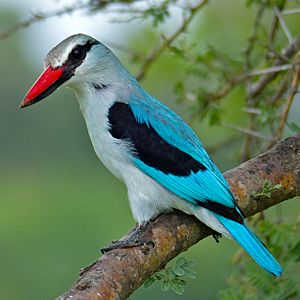 |
|
| Conservation status | |
| Scientific classification | |
| Synonyms | |
|
Alcedo senegalensis Linnaeus, 1766 |
The woodland kingfisher (Halcyon senegalensis) is a beautiful bird found across much of Africa, south of the Sahara Desert. It's a type of tree kingfisher, which means it usually lives in wooded areas rather than always near water.
Contents
About the Woodland Kingfisher's Name
Scientists give every living thing a special two-part name, like a first and last name. This is called binomial nomenclature. For the woodland kingfisher, its scientific name is Halcyon senegalensis.
The famous Swedish scientist Carl Linnaeus first described this bird in 1766. He gave it the name Alcedo senegalensis. Later, in 1821, another naturalist named William Swainson created the group (genus) Halcyon, and the woodland kingfisher became the main example for this group.
Different Types of Woodland Kingfishers
There are three slightly different types, or subspecies, of woodland kingfishers:
- H. s. fuscopileus: Found from Sierra Leone to southern Nigeria, and south into the Democratic Republic of the Congo and northern Angola.
- H. s. senegalensis: Lives from Senegal and Gambia all the way to Ethiopia and northern Tanzania.
- H. s. cyanoleuca: Found in southern Angola and western Tanzania, stretching down to South Africa.
What Does a Woodland Kingfisher Look Like?
This is a medium-sized kingfisher, about 23 centimeters (9 inches) long. Adult birds have a bright blue back, blue wings, and a blue tail. Their head, neck, and belly are white. They also have black patches on their shoulders.
The woodland kingfisher has a large, strong beak. The top part of the beak is red, and the bottom part is black. Their legs and feet are dark grey. When they fly, they move very fast and straight.
Spotting the Differences
Sometimes, it can be tricky to tell a woodland kingfisher apart from a mangrove kingfisher. Here are some clues:
- The woodland kingfisher has a dark stripe that goes through its eye. The mangrove kingfisher does not have this stripe going through its eye.
- The underside of the woodland kingfisher's wings is black with white patches.
- The chest of the woodland kingfisher is white.
Both male and female woodland kingfishers look similar. Young birds are a bit duller in color and have a brown beak instead of a red and black one.
What Does it Sound Like?
This bird is quite noisy! Its call sounds like a loud trill, almost like someone running a nail down the teeth of a comb.
Where Woodland Kingfishers Live
The woodland kingfisher lives across tropical Africa, south of the Sahara Desert. You can find them from Pretoria in South Africa all the way north.
These kingfishers usually stay in the same area if they live close to the equator. However, those living further north or south might migrate. They move towards the equator during the dry season to find better conditions.
Preferred Homes
Even though it's called a "kingfisher," this bird often prefers drier places. It likes wooded areas with trees, especially Acacia trees. You can even find them living near people's homes. They are often seen alone, but sometimes they gather in small groups.
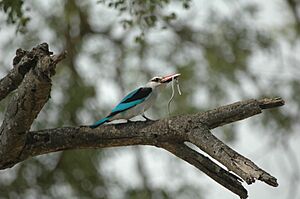
Woodland Kingfisher Behavior
Woodland kingfishers are very protective of their space. They will even attack intruders, including humans, if they feel their territory is threatened. They have a cool display where they spread their wings to show off the white feathers underneath.
Reproduction and Life Cycle
Woodland kingfishers don't build their own nests from scratch. Instead, they find holes in trees that were made by other birds, like woodpeckers or barbets.
A female kingfisher usually lays three round, white eggs. Both parents help take care of the young birds. They look after them for up to five weeks after the chicks leave the nest. In the Transvaal region of South Africa, woodland kingfishers usually breed from November to March, with most babies born in December and January.
What Do Woodland Kingfishers Eat?
These birds are skilled hunters. They often sit quietly on an exposed branch, like a dead tree branch, or in a shady spot. From this perch, they watch for food. Once they spot something, they quickly swoop down to catch it.



